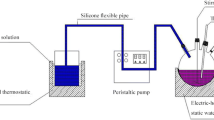Abstract
The effect of typical wood composite preservatives, ammonium pentaborate (APB), nanosize copper oxide and basic copper carbonate, on the cure characteristics of phenol formaldehyde (PF) resin in the presence of wood was evaluated by solid-state 13C nuclear magnetic resonance with cross-polarization and magic angle spinning (CP/MAS). With the introduction of APB the absorption intensity and peak area of PF resin at 129.5 ppm was reduced, and the carbons in methylene bridges shifted from 65.8 to 73.5 ppm, which were the result of hydrogen bond formation between ammonium in APB and oxygen of phenolic hydroxyl, as well as coordination bond between the boron in APB and oxygen in phenolic hydroxyl and/or unreacted hydroxymethyl. In addition, the peak area at 152.7 ppm increased with the addition of poplar powder for the overlap of cellulose, hemicellulose, and lignin chemical shifts with the active groups in PF resin. However, the connection status of critically active chemical groups of condensed polymer structure in cured PF resin such as the existence of phenolic ring, phenolic hydroxyl, methylene bridges, and hydroxymethyl linkage are unchanged. Combined with relative increase in the amount of carbon in methylene bridges from 2.42 to 2.56, drop in number of carbons of unreacted hydroxyls from 1.19 to 1.07, and the reported increase in physical and mechanical properties, the nanosize copper oxide improved the curing degree of PF. Furthermore, the similar analysis indicated that basic copper carbonate delayed the curing degree of PF.






Similar content being viewed by others
References
Chai L-L, Zakaria S, Chia C-H, Nabihah S, Rasid R (2009) Physico-mechanical properties of PF composite board from EFB fibres using liquefaction technique. Iran Polym J 18:917–923
Laborie MPG, Frazier CE (2006) 13C CP/MAS NMR study of a wood/phenol-formaldehyde resin bondline. J Mater Sci 41:6001–6005
Kamo N, Tanaka J, Higuchi M, Kondo T, Morita M (2006) Condensation reactions of phenolic resins. VII: catalytic effect of sodium bicarbonate for the condensation of hydroxymethylphenols. J Wood Sci 52:325–330
Abdalla AMA, Sekino N (2004) Veneer strand flanged I-beam with MDF or particleboard as web material. II: effect of resin type, application rate, strand dimension, and pressing time on the basic properties. J Wood Sci 50:400–406
Schmidt RG, Frazier CE (1998) 13C CP/MAS NMR as a direct probe of the wood-phenol formaldehyde adhesive bondline. Wood Fiber Sci 30:250–258
Rammon RM, Johns WE, Magnuson J, Dunker AK (1986) The chemical structure of UF resins. J Adhes 19:115–135
Vazquez G, Lopez-Suevos F, Villar-Garea A, Gonzalez-Alvarez J, Antorrena G (2004) 13C NMR analysis of phenol-urea-formaldehyde prepolymers and phenol-urea-formaldehyde-tannin adhesives. J Adhes Sci Technol 18:1529–1543
Werstler DD (1986) Quantitative 13C NMR characterization of aqueous formaldehyde resins. I: phenol-formaldehyde resins. Polymer 27:750–756
Gao W, Cao J, Li J (2010) Effect of ammonium pentaborate on the cure kinetics of aqueous phenol formaldehyde resin in the presence of wood. Iran Polym J 19:959–968
Gao W, Cao J, Li J (2010) Effect of ammonium pentaborate on curing of aqueous phenol formaldehyde resin. Iran Polym J 19:255–264
Duer MJ (2004) Introduction to solid-state NMR spectroscopy. Blackwell, Oxford
Liitiä T, Maunu SL, Hortling B (2000) Solid state NMR studies on cellulose crystallinity in fines and bulk fibres separated from refined kraft pulp. Holzforschung 54:618–624
Lennholm H, Iversen T (1995) Estimation of cellulose I and II in cellulosic samples by principal component analysis of 13C-CP/MAS-NMR-spectra. Holzforschung 49:119–126
Li J (2003) Wood spectroscopy. Science Press, Beijing
Gao W, Cao J, Kamdem DP (2011) Effect and mechanism of nanosize copper oxide on some physical and mechanical properties of flakeboards. Maderas Cienc Tecnol 13:203–210
Peer HG (1959) The reaction of phenol with formaldehyde. II. The ratio of ortho- and para-hydroxymethylphenol in the base-catalyzed hydroxymethylation of phenol. Rec Trav Chim 78:851–863
Acknowledgments
The author expresses his gratitude to the National Natural Science Foundation of China (grant 31100423) for financial support. The author also wish to thank Mr. Kevin Gleason from USA, and Ms. Rui Yin from the Faculty of Foreign Language in Southwest Forestry University, China, for their precious help on English writing improvement of this paper.
Author information
Authors and Affiliations
Corresponding author
Rights and permissions
About this article
Cite this article
Gao, W. 13C CP/MAS NMR analysis of cure characteristics of phenol formaldehyde resin in the presence of wood composite preservatives and wood: effect of ammonium pentaborate and copper compounds. Iran Polym J 21, 283–288 (2012). https://doi.org/10.1007/s13726-012-0030-5
Received:
Accepted:
Published:
Issue Date:
DOI: https://doi.org/10.1007/s13726-012-0030-5




